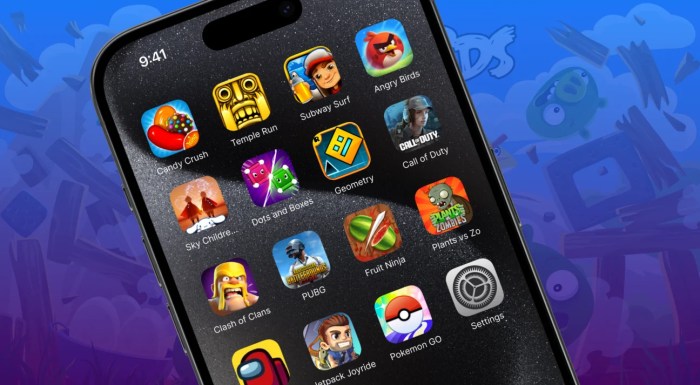
Ever wondered what makes a mobile game a global phenomenon? From Candy Crush’s addictive gameplay to the epic battles in Clash of Clans, the world of popular mobile online games is a fascinating blend of technology, psychology, and clever monetization. This exploration dives into the vibrant ecosystem of these games, uncovering the secrets behind their success, the challenges developers face, and the ever-evolving landscape of mobile gaming.
We’ll journey through the different genres, examining the mechanics that hook millions, the strategies that keep them playing (and spending!), and the social features that forge online communities. We’ll also touch upon the ethical considerations of in-game purchases, responsible gaming, and the unique challenges of designing games for diverse audiences. Get ready to level up your understanding of this multi-billion dollar industry!
Monetization Strategies in Popular Mobile Games
The mobile gaming industry is a multi-billion dollar behemoth, and a key ingredient in its success is sophisticated monetization. Developers employ various strategies to generate revenue, balancing player experience with profit maximization. Understanding these models is crucial to comprehending the industry’s dynamics and the choices players make within their favorite games.
Monetization in mobile games isn’t a one-size-fits-all approach. Different models cater to diverse game designs and player expectations. Some games prioritize a smooth, uninterrupted experience, while others lean towards a more transactional system. The success of a monetization strategy depends heavily on its integration into the game’s core mechanics and the overall player experience.
Freemium Model
The freemium model is arguably the most prevalent monetization strategy in mobile gaming. It allows players to download and play the game for free, but offers in-app purchases (IAPs) for cosmetic items, power-ups, or premium content. This model relies on attracting a large player base and converting a smaller percentage into paying customers. A well-designed freemium model can be highly profitable, provided the free content is engaging enough to retain players and the IAPs are perceived as valuable additions, not essential for progress.
Pay-to-Win Model
The pay-to-win model is controversial. In this model, players can purchase in-game advantages that directly impact their gameplay, providing a significant competitive edge over free-to-play players. This can create an uneven playing field and lead to frustration among those unwilling or unable to spend money. While it can be highly lucrative for developers, it often alienates a large segment of the player base and negatively impacts player retention.
Subscription Model
The subscription model offers players access to premium content, features, or benefits for a recurring fee. This model prioritizes player retention and provides a predictable revenue stream for developers. Subscription models often include perks like exclusive items, early access to content, and ad-free experiences. The success of a subscription model depends on providing significant value to justify the recurring cost.
Comparison of Monetization Models
The following table compares the pros and cons of each model:
| Monetization Model | Pros | Cons | Examples |
|---|---|---|---|
| Freemium | Wide player base, potential for high revenue, flexible implementation | Can feel exploitative if IAPs are too aggressive, potential for pay-to-win elements | Candy Crush Saga, Pokémon GO |
| Pay-to-Win | High revenue potential, can incentivize spending | Alienates players, creates uneven playing field, negative impact on player retention | Some mobile MMOs (often criticized for this model) |
| Subscription | Predictable revenue, fosters player loyalty, provides value for money | Requires significant initial investment, can be less accessible to casual players | Many mobile games with ongoing content updates (often include freemium elements as well) |
The Role of Social Features in Popular Mobile Games
Social interaction is no longer a mere add-on in mobile games; it’s a cornerstone of their success. The ability to connect with other players, compete, collaborate, and build communities significantly impacts player engagement and retention, transforming a solitary experience into a vibrant, shared adventure. Games that effectively leverage social features often see higher player retention rates, increased playtime, and ultimately, more revenue.The impact of social features on player engagement and retention is multifaceted.
Leaderboards foster competition, driving players to improve their skills and strive for higher rankings. Guilds and alliances create a sense of belonging and shared purpose, encouraging teamwork and cooperation. In-game chat facilitates communication, allowing players to strategize, share tips, and build relationships. These features aren’t just fun additions; they are powerful tools that keep players coming back for more.
The feeling of community, the thrill of competition, and the support of friends all contribute to a more immersive and rewarding gaming experience.
Best Practices for Implementing Effective Social Features
Effective social features are not simply bolted on; they need to be seamlessly integrated into the game’s design and mechanics. Poorly implemented features can be frustrating and lead to player churn. Careful consideration of the target audience and game genre is crucial.
- Intuitive and Easy-to-Use Interface: Social features should be readily accessible and easy to navigate. Clunky interfaces will frustrate players and discourage interaction.
- Clear Goals and Rewards: Incentivize social interaction with rewards such as in-game currency, exclusive items, or achievement badges. This encourages players to participate actively.
- Diverse Social Mechanics: Offer a variety of social interactions, catering to different player preferences. Some might prefer competitive leaderboards, while others might value collaborative guild activities.
- Moderation and Community Management: Implement robust moderation systems to maintain a positive and respectful environment. Active community management helps foster a sense of community and address player concerns.
- Cross-Platform Compatibility: Allow players to connect regardless of the platform they’re using (iOS, Android, etc.). This expands the potential player base and enhances social interaction.
Examples of Successful Social Feature Implementation
Several popular mobile games exemplify the power of effective social features.
- Clash of Clans: This strategy game’s success is heavily reliant on its guild system (Clans). Players join clans to collaborate on attacks, share resources, and participate in clan wars. The competitive aspect of clan wars, coupled with the collaborative nature of clan activities, keeps players engaged and returning daily.
- Candy Crush Saga: While primarily a solo game, Candy Crush Saga cleverly incorporates social features. Players can connect with friends, send and receive lives, and compete on leaderboards. This subtle integration of social elements adds a layer of friendly competition and keeps players connected to their social circles.
- Pokémon GO: This augmented reality game uses location-based features to encourage social interaction. Players can team up to battle gym leaders, participate in raids, and explore their surroundings together. The game’s social aspect, coupled with the unique gameplay, creates a compelling experience that fosters community and exploration.
Online Game Development
Creating captivating mobile online games is a thrilling but challenging endeavor. The market is fiercely competitive, demanding constant innovation and adaptation to keep players engaged and coming back for more. Success hinges on a delicate balance of compelling gameplay, engaging social features, and a robust, scalable technical foundation. This section delves into the significant hurdles developers face and explores the emerging trends shaping the future of mobile online gaming.
Key Challenges in Mobile Online Game Development
The path to creating a successful mobile online game is fraught with obstacles. Developers must navigate a complex landscape of technical limitations, market saturation, and evolving player expectations. These challenges require careful planning, skilled execution, and a deep understanding of the target audience.
- Maintaining Player Engagement: In a market flooded with options, keeping players hooked requires continuous updates, new content, and engaging events. Games must offer a compelling loop that keeps players returning for more, whether it’s through daily rewards, competitive leaderboards, or a constantly evolving narrative.
- Monetization Strategies: Finding the right balance between monetization and player experience is crucial. Aggressive monetization can alienate players, while insufficient revenue streams can hinder development and sustainability. Careful consideration of in-app purchases, advertisements, and subscription models is vital.
- Technical Challenges: Developing for multiple mobile platforms (iOS and Android) presents unique technical hurdles. Ensuring cross-platform compatibility, optimizing performance for a wide range of devices, and managing server infrastructure are significant challenges that require expertise in various technologies.
- Balancing Game Design and Development: Striking the right balance between innovative gameplay and technically feasible development is paramount. Ambitious game designs might require substantial resources and time, potentially impacting release timelines and budgets. Careful planning and iterative development are key to managing this challenge.
- Security and Privacy Concerns: Protecting player data and preventing cheating are crucial aspects of mobile online game development. Implementing robust security measures and complying with data privacy regulations are essential to maintaining player trust and avoiding legal issues.
Current Trends in Mobile Online Game Development
The mobile gaming landscape is constantly evolving, with new trends emerging regularly. Staying ahead of the curve is essential for developers aiming to create successful and enduring games.
- Hypercasual Games: Simple, easy-to-learn games with addictive gameplay loops continue to dominate the charts. These games often leverage short play sessions and easily shareable content to attract a broad audience.
- Cloud Gaming: Streaming games directly to mobile devices is gaining traction, allowing players to access high-quality graphics and complex games without needing powerful hardware. This trend reduces the barrier to entry for graphically intensive titles.
- Integration of Metaverse Elements: The integration of virtual worlds and digital assets into mobile games is becoming increasingly prevalent. This allows for more immersive experiences and the creation of unique in-game economies.
- AI-Powered Game Design: Artificial intelligence is being used to create more dynamic and responsive game environments, personalize player experiences, and even generate game content automatically.
- Focus on Accessibility and Inclusivity: Developers are increasingly prioritizing accessibility features to ensure their games can be enjoyed by a wider range of players, including those with disabilities.
Comparison of Mobile Game Engines
Choosing the right game engine is a crucial decision for mobile game developers. Different engines offer varying strengths and weaknesses, impacting development speed, performance, and cost.
| Game Engine | Strengths | Weaknesses | Suitable for |
|---|---|---|---|
| Unity | Cross-platform compatibility, large community, extensive resources, versatile | Can be resource-intensive, learning curve can be steep | 2D and 3D games, AR/VR applications |
| Unreal Engine | High-fidelity graphics, powerful tools, robust physics engine | Steeper learning curve, resource-intensive, generally better suited for high-end devices | High-fidelity 3D games |
| GameMaker Studio 2 | Easy to learn, suitable for beginners, good for 2D games | Limited 3D capabilities | 2D games, casual games |
| Cocos2d-x | Open-source, good performance, suitable for cross-platform development | Smaller community compared to Unity or Unreal Engine | 2D and 3D games |
Free Online Games and Their Business Models

The seemingly paradoxical success of free-to-play (F2P) mobile games rests on cleverly designed monetization strategies that generate substantial revenue without requiring upfront payment. These games expertly leverage player psychology and in-app purchases to create a sustainable and often highly profitable business model. Instead of a one-time purchase, players are encouraged to spend money throughout their gameplay experience.Free-to-play games generate revenue through a variety of methods, all carefully integrated into the game’s design to maximize engagement and spending.
These methods are often used in combination to create a comprehensive monetization system. The key is to provide enough free content to attract and retain players while simultaneously offering enticing paid options that enhance the gaming experience.
Monetization Strategies in Free-to-Play Mobile Games
Several core strategies underpin the financial success of free-to-play mobile games. These strategies are often combined to create a balanced and effective monetization system. The goal is not to force players to pay, but to subtly incentivize spending among those who enjoy the game and are willing to invest in enhancing their experience.
- In-App Purchases (IAPs): This is the most common monetization method. IAPs can range from cosmetic items like skins and outfits to functional upgrades like power-ups, extra lives, or premium currency. Games like Candy Crush Saga and Clash of Clans heavily rely on IAPs for their revenue.
- Advertisements: Many free-to-play games incorporate rewarded video ads. Players can watch short ads to earn in-game rewards, such as currency, power-ups, or extra lives. This provides a non-intrusive way to generate revenue while rewarding players for their time.
- Subscription Models: Some games offer subscription services that unlock premium features, content, or benefits. These subscriptions often provide ongoing value to players, making them a recurring revenue stream. Examples include games with monthly battle passes that offer exclusive rewards.
- Loot Boxes and Gacha Mechanics: These systems involve purchasing virtual “loot boxes” or “gacha” with a random chance of obtaining valuable in-game items. While controversial due to their potential for addictive behavior, they are a significant revenue generator for many games. Games like Genshin Impact use this system effectively.
Examples of Successful Free-to-Play Games and Their Monetization Strategies
Many successful mobile games showcase the effectiveness of various monetization strategies.
- Candy Crush Saga: This puzzle game primarily uses in-app purchases for extra lives and power-ups. The game’s addictive gameplay loop and well-timed prompts to purchase encourage spending.
- Clash of Clans: This strategy game relies heavily on in-app purchases for in-game currency, upgrades, and cosmetic items. The game’s social aspects and competitive gameplay further incentivize spending.
- Pokémon GO: This augmented reality game uses in-app purchases for items like Poké Balls and lures, along with sponsored locations that increase player engagement and offer opportunities for brand partnerships.
User Journey and Revenue Streams Flowchart
Imagine a flowchart with the following stages:
1. Player Acquisition
(Start)Marketing campaigns, app store optimization attract new players.
2. Onboarding
The player downloads the game and experiences the tutorial. The game showcases free features to create engagement.
3. Gameplay
The player starts playing, gradually encountering limitations in free gameplay.
4. Engagement
The player progresses and enjoys the game, potentially encountering paywalls or limitations.
5. Monetization Point
The player encounters a paywall or an opportunity to purchase items to enhance gameplay. (Decision Point: Purchase or Not)
6. Purchase
(If yes) The player makes an in-app purchase, generating revenue.
7. Continued Gameplay
(If yes or no) The player continues playing, potentially reaching another monetization point.
8. Retention
The game’s design and features aim to retain players over time, leading to more potential monetization points.
9. Churn
(End) The player stops playing.Each stage, especially the monetization point, leads to a revenue stream: IAPs, Ads, Subscriptions, etc. The flowchart visually represents how a player progresses through the game and how revenue is generated at various points.
Mobile Games for Girls
The mobile gaming market is vast and diverse, but certain genres and design elements resonate particularly well with female players. Understanding these preferences is crucial for developers seeking to create successful and engaging mobile games specifically targeted at this audience. While generalizations about any demographic group should be approached with caution, observational data and market trends reveal consistent preferences.Successful mobile games for girls often prioritize engaging narratives, customization options, and social interaction, often diverging from the fast-paced, competitive focus prevalent in many games aimed at male audiences.
This doesn’t mean that girls don’t enjoy competition, but the presentation and context are key differentiators.
Popular Genres Appealing to Female Gamers
Many successful mobile games targeting female players leverage genres that emphasize creativity, social connection, and narrative-driven experiences. These often include simulation, life simulation, puzzle, and dress-up games. Simulation games, for instance, allow players to build and manage virtual worlds, fostering a sense of accomplishment and control. Puzzle games, particularly those with visually appealing designs and challenging yet achievable gameplay, are also very popular.
Dress-up games offer opportunities for self-expression and creativity, allowing players to design avatars and outfits.
Design Considerations for Female Gamers
Appealing to female gamers requires more than just choosing a popular genre. Design choices play a significant role in creating an engaging and immersive experience. Visually appealing graphics with a focus on detail and aesthetics are highly valued. A clean, intuitive user interface that is easy to navigate is also essential. Furthermore, a strong narrative or compelling storyline can significantly enhance player engagement and retention.
Games that allow for significant character customization and personalization cater to a desire for self-expression and agency within the game world. Finally, the integration of social features, such as the ability to connect with friends and share progress, enhances the overall experience.
Examples of Successful Mobile Games Targeting Female Gamers
Several mobile games have achieved significant success by catering specifically to female gamers. Covet Fashion, a popular dress-up and styling game, allows players to create virtual outfits and participate in fashion competitions. Its focus on style, creativity, and social interaction has made it a significant hit. Similarly, games like My Cafe: Recipes & Stories and Restaurant Story blend simulation and social elements, allowing players to manage their own virtual cafes or restaurants.
The focus on building relationships with virtual characters and decorating spaces resonates well with many female players. These examples highlight the successful integration of narrative, social interaction, and aesthetic appeal, showcasing the key design considerations for creating engaging mobile games for girls.
The Landscape of Online Gambling and its Relation to Mobile Gaming
The convergence of mobile gaming and online gambling presents a complex landscape, fraught with both immense potential and significant challenges. The accessibility of smartphones and the ever-increasing sophistication of mobile game design have created a fertile ground for the integration of gambling mechanics, blurring the lines between casual entertainment and potentially addictive behavior. This integration necessitates a careful consideration of legal frameworks, ethical implications, and the potential consequences for players.The integration of gambling features into mobile games raises several critical legal and ethical considerations.
Many jurisdictions have specific regulations regarding online gambling, including licensing requirements, age restrictions, and measures to prevent underage gambling and problem gambling. These regulations vary widely across countries and regions, making it challenging for developers to navigate the legal landscape. Ethical concerns center on the potential for exploitation of vulnerable populations, particularly children and individuals prone to addiction.
The use of persuasive design techniques, such as reward systems and in-app purchases, can exacerbate these risks. Furthermore, the lack of robust regulatory oversight in some regions creates a breeding ground for illicit activities and unfair practices. The responsibility of ensuring ethical and responsible gaming practices rests heavily on developers, publishers, and regulatory bodies alike.
Online Casino Free Spins and Online Casino Affiliates
Online casino free spins are promotional offers provided by online casinos to attract and retain players. These typically involve a set number of free spins on specific slots games, often requiring a minimum deposit or registration. In the context of mobile gaming, free spins are frequently integrated as rewards within games or offered through partnerships with online casinos.
The mechanics usually involve the player triggering the free spins within the game, potentially leading to winnings that can be exchanged for real money or in-game currency. Affiliates, on the other hand, act as intermediaries between online casinos and players. They promote the casinos through various channels, including websites, social media, and mobile game advertising. Affiliates earn commissions on the revenue generated by players they refer to the casinos.
This affiliate model is a common monetization strategy in the mobile gaming industry, particularly when integrated with gambling features. A successful affiliate program often relies on targeted advertising, compelling promotional materials, and a robust tracking system to monitor player activity and commission payments.
Risks and Rewards of Incorporating Gambling Elements into Mobile Games
Incorporating gambling elements into mobile games presents a double-edged sword. The potential rewards include significant revenue generation through in-app purchases and microtransactions related to gambling features. For example, a popular mobile game featuring a virtual casino could generate substantial revenue through the sale of virtual chips, free spins, and other in-game items. However, the risks are equally substantial.
The potential for addiction, financial loss, and regulatory penalties are significant concerns. The inherent addictive nature of gambling mechanisms, combined with the readily accessible nature of mobile games, creates a high-risk environment. Moreover, the legal and ethical complexities associated with gambling integration can lead to costly legal battles and reputational damage. Therefore, a careful risk assessment and a robust responsible gaming strategy are essential for any developer considering incorporating gambling elements into their mobile game.
This strategy might include implementing strict age verification, responsible gambling tools (such as deposit limits and self-exclusion options), and clear communication regarding the risks of gambling. Ignoring these aspects can lead to severe consequences, impacting not only the financial success of the game but also the well-being of the players.
Responsible Gaming Practices in Mobile Games
The integration of gambling mechanics into mobile games presents a unique challenge: balancing engaging gameplay with the crucial responsibility of protecting players from potential harm. Developers must proactively implement robust responsible gaming practices to minimize the risks associated with gambling addiction and ensure a safe and enjoyable experience for all users. This requires a multifaceted approach encompassing clear warnings, accessible safeguards, and readily available resources for players who may need help.Responsible gaming features are not merely a compliance measure; they are a vital component of building trust and fostering a positive player experience.
Games that prioritize responsible gaming often enjoy enhanced player loyalty and a stronger reputation within the gaming community. This section will explore effective strategies and examples of successful implementations.
Best Practices for Promoting Responsible Gaming Habits
Promoting responsible gaming requires a proactive and multi-pronged approach. It’s not enough to simply include a disclaimer; developers must actively encourage healthy gaming habits through various in-game mechanisms and external resources. This includes setting clear limits on spending and playtime, providing easy access to self-exclusion options, and offering educational materials about responsible gaming. Furthermore, integrating these features seamlessly into the game’s user interface ensures they are easily accessible and not hidden away.
Designing Effective Warnings and Safeguards Against Gambling Addiction
Effective warnings must be clear, concise, and readily apparent to the player. They should not be easily dismissed or overlooked. For example, a pop-up warning appearing before each in-game purchase, clearly stating the financial commitment and offering a simple “cancel” option, is more effective than a small, easily missed notice buried in the terms and conditions. Safeguards should be equally prominent and easy to use.
This includes features such as daily/weekly spending limits, time limits on gameplay sessions, and readily accessible self-exclusion options. These options should allow players to temporarily or permanently restrict their access to gambling features within the game.
Examples of Responsible Gaming Features in Successful Mobile Games
Several successful mobile games have implemented effective responsible gaming features. For example, some casino-style games offer players the ability to set daily or weekly spending limits, receive regular reminders of their spending, and easily access self-exclusion tools. These features are often integrated directly into the game’s settings menu, making them easily accessible. Other games provide links to external resources and organizations dedicated to responsible gaming, offering players support and guidance if needed.
These features are not only crucial for player well-being but also contribute to a positive and sustainable game environment. One notable example could be a game that prominently displays a player’s total spending for the current session, along with a clear visual representation of their remaining budget, if one has been set. This constant visual reminder can help players stay within their set limits.
Summary

The world of popular mobile online games is a dynamic and ever-changing landscape, driven by technological innovation, evolving player preferences, and increasingly sophisticated monetization strategies. While the quest for the next viral sensation continues, understanding the underlying principles of successful game design, player engagement, and responsible gaming practices remains crucial. Whether you’re a seasoned gamer, a curious observer, or an aspiring game developer, this exploration has hopefully shed light on the compelling story behind the games that dominate our smartphones.
Quick FAQs
What are the biggest challenges in mobile game development?
Balancing fun gameplay with monetization, attracting and retaining players, keeping up with technological advancements, and navigating a highly competitive market are all significant hurdles.
How do free-to-play games make money?
Free-to-play games generate revenue through in-app purchases, advertisements, and sometimes subscription models. These can range from cosmetic items to powerful in-game advantages.
What are some examples of successful free-to-play mobile games?
Examples include Candy Crush Saga, PUBG Mobile, and Pokémon GO, all of which have mastered various monetization techniques.
Are there any legal issues surrounding in-app purchases?
Yes, there are ongoing debates and regulations regarding potentially manipulative in-app purchase practices, particularly those targeting children.
What makes a mobile game “addictive”?
A combination of factors contributes, including rewarding gameplay loops, clear progression systems, social features, and clever use of psychological principles.





